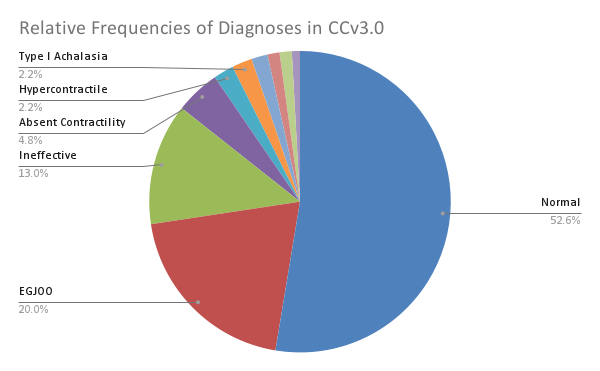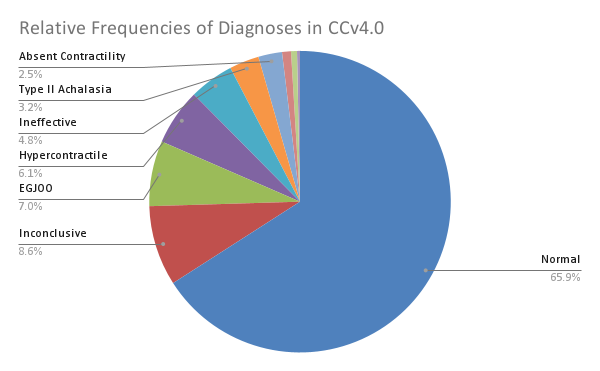Tuesday Poster Session
Category: Esophagus
P4940 - Comparing Trends in Esophageal Motility Disorder Diagnoses Between the Chicago Classification v3.0 (CCv3.0) and the Chicago Classification v4.0 (CCv4.0) in a Community Hospital Setting
Tuesday, October 28, 2025
10:30 AM - 4:00 PM PDT
Location: Exhibit Hall

Kyle S. Hamann, DO
Riverside Medical Center
Lemont, IL
Presenting Author(s)
Kyle S. Hamann, DO1, Nancy Mayer, DO2, Paul Kozak, DO2, Matthew Kaplan, DO3
1Riverside Medical Center, Lemont, IL; 2Riverside Medical Center, Kankakee, IL; 3Digestive Disease Consultants, Bourbonnais, IL
Introduction: The Chicago Classification is utilized for the diagnosis of esophageal motility disorders. The Classification has been updated multiple times, with its most recent update from CCv3.0 to CCv4.0 in 2020.The CCv4.0 update placed a larger emphasis on correlating clinical symptoms, more stringent diagnostic criteria for EGJ outflow obstruction (EGJOO), and utilization of adjunctive testing. The aim of this study was to analyze how these new diagnostic implementations influence the epidemiology of esophageal motility disorders from before and after the change. We anticipate that with the more stringent criteria in CCv4.0, the relative frequency of EGJOO and Ineffective Esophageal Motility (IEM) should decrease. Similarly, we anticipate the relative frequency of inconclusive and normal studies will increase.
Methods: We performed a retrospective observational study on patients undergoing work up for suspected esophageal motility disorders in one community hospital outpatient center from January 2019 through August 2024. Patients were sorted into those evaluated during periods in which CCv3.0 was utilized (n=230) and those during which CCv4.0 was used (n=314). Relative percentages of each diagnosis were analyzed across the two populations.
Results: Our population was 556 patients with an average age of 59.16 years old (SD 14.2). It is noted that 12 patients were excluded during the chart review period. Populations were separated by those evaluated using CCv3.0 (January 2019 to April 2021) and CCv4.0 (April 2021 to August 2024). Relative frequencies of diagnosis were compared between the two populations. Chi-squared analysis was performed to evaluate statistical significance of differences in relative frequencies. Relative frequency of EGJOO diagnosis decreased from 20% in CCv3.0 to 9% in CC4.0 (p< .00001; Chi^2=20.49). IEM decreased from a relative frequency of 13% in CCv3.0 to 5% in CCv4.0 (p< .000545; Chi^2=11.96). Inconclusive diagnoses were not part of the CCv3.0 system, but encompassed the second highest frequency of abnormal diagnosis in the CCv4.0 population at 9%.
Discussion: Through our study, we found a statistically significant decrease in the relative frequency of EGJOO and IEM diagnoses between the patients evaluated with the CCv3.0 criteria compared to the CCv4.0 criteria. This difference was explained by an increase in normal and inconclusive diagnoses. We hypothesize that this change is due to the more stringent diagnostic criteria for EGJOO and IEM utilized in CCv4.0.

Figure: Pie chart representing the relative frequencies of diagnoses evaluated using the Chicago Classification version 3.0

Figure: Pie chart representing the relative frequencies of diagnoses evaluated using the Chicago Classification version 4.0
Disclosures:
Kyle Hamann indicated no relevant financial relationships.
Nancy Mayer indicated no relevant financial relationships.
Paul Kozak indicated no relevant financial relationships.
Matthew Kaplan indicated no relevant financial relationships.
Kyle S. Hamann, DO1, Nancy Mayer, DO2, Paul Kozak, DO2, Matthew Kaplan, DO3. P4940 - Comparing Trends in Esophageal Motility Disorder Diagnoses Between the Chicago Classification v3.0 (CCv3.0) and the Chicago Classification v4.0 (CCv4.0) in a Community Hospital Setting, ACG 2025 Annual Scientific Meeting Abstracts. Phoenix, AZ: American College of Gastroenterology.
1Riverside Medical Center, Lemont, IL; 2Riverside Medical Center, Kankakee, IL; 3Digestive Disease Consultants, Bourbonnais, IL
Introduction: The Chicago Classification is utilized for the diagnosis of esophageal motility disorders. The Classification has been updated multiple times, with its most recent update from CCv3.0 to CCv4.0 in 2020.The CCv4.0 update placed a larger emphasis on correlating clinical symptoms, more stringent diagnostic criteria for EGJ outflow obstruction (EGJOO), and utilization of adjunctive testing. The aim of this study was to analyze how these new diagnostic implementations influence the epidemiology of esophageal motility disorders from before and after the change. We anticipate that with the more stringent criteria in CCv4.0, the relative frequency of EGJOO and Ineffective Esophageal Motility (IEM) should decrease. Similarly, we anticipate the relative frequency of inconclusive and normal studies will increase.
Methods: We performed a retrospective observational study on patients undergoing work up for suspected esophageal motility disorders in one community hospital outpatient center from January 2019 through August 2024. Patients were sorted into those evaluated during periods in which CCv3.0 was utilized (n=230) and those during which CCv4.0 was used (n=314). Relative percentages of each diagnosis were analyzed across the two populations.
Results: Our population was 556 patients with an average age of 59.16 years old (SD 14.2). It is noted that 12 patients were excluded during the chart review period. Populations were separated by those evaluated using CCv3.0 (January 2019 to April 2021) and CCv4.0 (April 2021 to August 2024). Relative frequencies of diagnosis were compared between the two populations. Chi-squared analysis was performed to evaluate statistical significance of differences in relative frequencies. Relative frequency of EGJOO diagnosis decreased from 20% in CCv3.0 to 9% in CC4.0 (p< .00001; Chi^2=20.49). IEM decreased from a relative frequency of 13% in CCv3.0 to 5% in CCv4.0 (p< .000545; Chi^2=11.96). Inconclusive diagnoses were not part of the CCv3.0 system, but encompassed the second highest frequency of abnormal diagnosis in the CCv4.0 population at 9%.
Discussion: Through our study, we found a statistically significant decrease in the relative frequency of EGJOO and IEM diagnoses between the patients evaluated with the CCv3.0 criteria compared to the CCv4.0 criteria. This difference was explained by an increase in normal and inconclusive diagnoses. We hypothesize that this change is due to the more stringent diagnostic criteria for EGJOO and IEM utilized in CCv4.0.

Figure: Pie chart representing the relative frequencies of diagnoses evaluated using the Chicago Classification version 3.0

Figure: Pie chart representing the relative frequencies of diagnoses evaluated using the Chicago Classification version 4.0
Disclosures:
Kyle Hamann indicated no relevant financial relationships.
Nancy Mayer indicated no relevant financial relationships.
Paul Kozak indicated no relevant financial relationships.
Matthew Kaplan indicated no relevant financial relationships.
Kyle S. Hamann, DO1, Nancy Mayer, DO2, Paul Kozak, DO2, Matthew Kaplan, DO3. P4940 - Comparing Trends in Esophageal Motility Disorder Diagnoses Between the Chicago Classification v3.0 (CCv3.0) and the Chicago Classification v4.0 (CCv4.0) in a Community Hospital Setting, ACG 2025 Annual Scientific Meeting Abstracts. Phoenix, AZ: American College of Gastroenterology.
